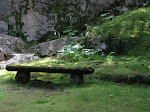Liza Mundy’s article in this week’s Washington Post Magazine relieves me of my green guilt. I thought I was the only one who just couldn't quite get it right. Yes, I want to be environmentally conscious, I want to reduce my carbon footprint. But, I drive a large American, gas-guzzling suv (aka “Texas Cadillac”) but I often am hauling plants, tools and a smattering of neighborhood kids. My friends know I cannot say “no” when they ask if I can snag their kids after school because I have room for the kids and the 60-pound backpacks, with room to spare.
I want to compost, but I don’t want vermin in my yard (“sure kids, that is a cute mouse”). I try very hard to unplug anything that we’re not using and turn off the lights. But I really hate to be cold (I like my forced heat). I really hate to be hot (I love my A/C). Most of the time, I remember the reusable grocery bags. But sometimes I need the plastic bags to pick up dog poop. High school and college tuition bills are looming, so adding solar panels on the roof is still a few years away. Our family is better about recycling, but I still question where it really goes after being dumped in the orange truck. I know, excuses, excuses.
Surely there’s something I can do? My expertise is in the outside world, that’s where I can focus my efforts. No, I’m not off to South America to save a rain forest, but I’m working here to help green our city, in my yard and in my community. Five easy steps and you can be a little greener too.
1. Water your street tree (the one your city planted along your sidewalk). Street trees have an average life span of 8 years (yes, 8 years) because of the stresses from car exhaust, confined growing spaces, and poor pruning techniques employed by your local utility company. Add to that any period of drought, and a tree’s chance of survival is drastically reduced. Newly planted trees should be given a good soaking (20-30 minutes) about once a week after planting through fall (until the ground freezes). For young trees (2-5 years), watering once a month during late spring and summer, and more frequently during long periods without rain, will be sufficient. Very mature trees generally have adapted to their environment and would only need supplemental watering in times of drought.
2. Pick up litter that you see on the ground. Remember the 1970s commercials with the Indian? A no-brainer, and can you really walk past it?
3. Plant one new tree in your yard. Not only does it help absorb carbon dioxide, but it can create shade in the summer that keeps your house cooler. The birds will like the new digs, too.
4. Do not install plants that require lots of extra watering, chemicals or fertilizers to look pretty. Yes, using plants that are native to your environment means that they can adapt to the changing weather conditions and the extremes in humidity and temperatures. Chemicals and fertilizers run off your yard and into the sewer system and into nearby waterways. Very bad, ask the fish.
5. Mow your lawn less. Unless you’re having a garden party in April, start a week or two later in spring than normal. In the heat of the summer when it hasn’t rained much, skip your weekly mowing -- the grass isn’t growing if it’s really hot and dry (does grass grow in the desert?) and your lawn doesn’t need to be cut if it isn’t growing.
Kermit was right. But I’m still trying . . .
Subscribe to:
Post Comments (Atom)



No comments:
Post a Comment